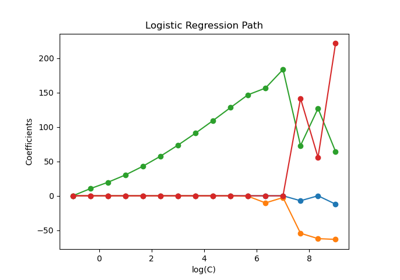-
sklearn.svm.l1_min_c(X, y, loss='squared_hinge', fit_intercept=True, intercept_scaling=1.0)[source] -
Return the lowest bound for C such that for C in (l1_min_C, infinity) the model is guaranteed not to be empty. This applies to l1 penalized classifiers, such as LinearSVC with penalty=?l1? and linear_model.LogisticRegression with penalty=?l1?.
This value is valid if class_weight parameter in fit() is not set.
Parameters: X : array-like or sparse matrix, shape = [n_samples, n_features]
Training vector, where n_samples in the number of samples and n_features is the number of features.
y : array, shape = [n_samples]
Target vector relative to X
loss : {?squared_hinge?, ?log?}, default ?squared_hinge?
Specifies the loss function. With ?squared_hinge? it is the squared hinge loss (a.k.a. L2 loss). With ?log? it is the loss of logistic regression models. ?l2? is accepted as an alias for ?squared_hinge?, for backward compatibility reasons, but should not be used in new code.
fit_intercept : bool, default: True
Specifies if the intercept should be fitted by the model. It must match the fit() method parameter.
intercept_scaling : float, default: 1
when fit_intercept is True, instance vector x becomes [x, intercept_scaling], i.e. a ?synthetic? feature with constant value equals to intercept_scaling is appended to the instance vector. It must match the fit() method parameter.
Returns: l1_min_c: float :
minimum value for C
sklearn.svm.l1_min_c()
Examples using
2025-01-10 15:47:30

Please login to continue.